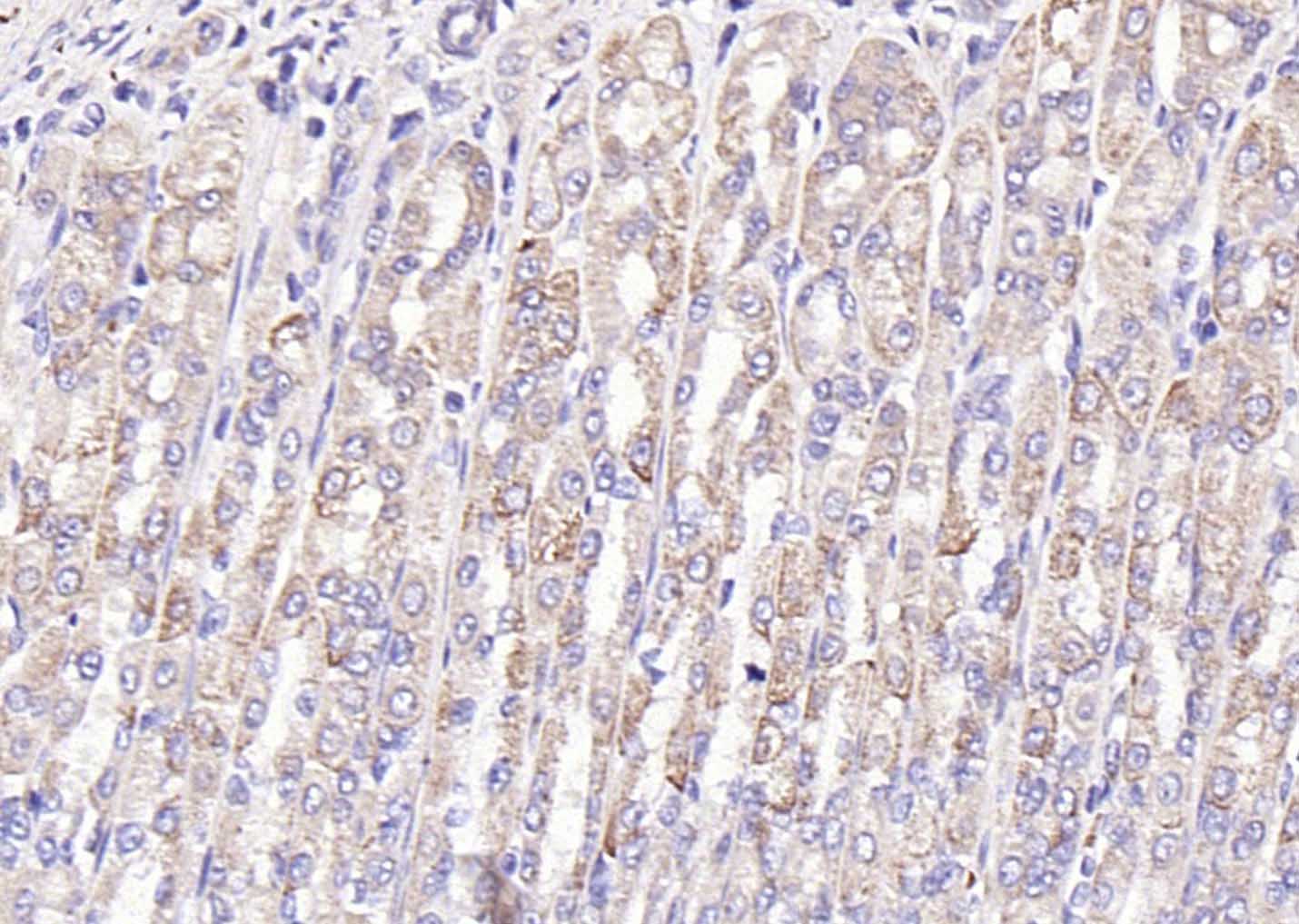
Rabbit Anti-Gastrin antibody
Gastrin component II; Gastrin-34; Gastrin 34; Gastrin34; G34; Gastrin component III; Gastrin-17; Gastrin 17; Gastrin17; G17; GAS; GAST; Gastrin precursor; Bombesin; gastrin big; Gastrin-71; Gastrin 71; Gastrin71; Gastrin-52; Gastrin 52; Gastrin52; Big gas
View History [Clear]
Details
Product Name Gastrin Chinese Name 胃泌素/蛙皮素抗体 Alias Gastrin component II; Gastrin-34; Gastrin 34; Gastrin34; G34; Gastrin component III; Gastrin-17; Gastrin 17; Gastrin17; G17; GAS; GAST; Gastrin precursor; Bombesin; gastrin big; Gastrin-71; Gastrin 71; Gastrin71; Gastrin-52; Gastrin 52; Gastrin52; Big gastrin; Gastrin-14; Gastrin 14; Gastrin14; G14; Gastrin-6; Gastrin 6; Gastrin6; G6; Gastrin; Gastrin component I; G52; GAST_HUMAN. literatures Research Area Growth factors and hormones Immunogen Species Rabbit Clonality Polyclonal React Species Rat, (predicted: Human, Mouse, Pig, Rabbit, ) Applications ELISA=1:5000-10000 IHC-P=1:100-500 IHC-F=1:100-500 IF=1:100-500 (Paraffin sections need antigen repair)
not yet tested in other applications.
optimal dilutions/concentrations should be determined by the end user.Theoretical molecular weight 2.1/3.9/6/8kDa Cellular localization Secretory protein Form Liquid Concentration 1mg/ml immunogen KLH conjugated synthetic peptide derived from human Gastrin: 77-92/101 Lsotype IgG Purification affinity purified by Protein A Buffer Solution 0.01M TBS(pH7.4) with 1% BSA, 0.03% Proclin300 and 50% Glycerol. Storage Shipped at 4℃. Store at -20 °C for one year. Avoid repeated freeze/thaw cycles. Attention This product as supplied is intended for research use only, not for use in human, therapeutic or diagnostic applications. PubMed PubMed Product Detail Gastrin is mainly known by its first described role as a gastric acid-hormone but the protein also has the ability to promote cellular growth. More recently, gastrin has been suggested to induce leukocyte-endothelial cell interactions and to have a pro-inflammatory effect. Gastrin has two biologically active peptide forms, G34 and G17 and they activate two different receptors: the CCK-1 receptor, which has low affinity for gastrin but high affinity for the related hormone cholecystokinin (CCK), and the CCK-2 receptor, which has high affinity for both gastrin and CCK and mediates the acid-secretory as well as the proliferative effects of gastrin.
Function:
Gastrin stimulates the stomach mucosa to produce and secrete hydrochloric acid and the pancreas to secrete its digestive enzymes. It also stimulates smooth muscle contraction and increases blood circulation and water secretion in the stomach and intestine.
Subcellular Location:
Secreted.
Post-translational modifications:
Two different processing pathways probably exist in antral G-cells. In the dominant pathway progastrin is cleaved at three sites resulting in two major bioactive gastrins, gastrin-34 and gastrin-17. In the putative alternative pathway, progastrin may be processed only at the most C-terminal dibasic site resulting in the synthesis of gastrin-71.
Sulfation enhances proteolytic processing, and blocks peptide degradation. Levels of sulfation differ between proteolytically-cleaved gastrins. Thus, gastrin-6 is almost 73% sulfated, whereas the larger gastrins are less than 50% sulfated. Sulfation levels are also tissue-specific.
Similarity:
Belongs to the gastrin/cholecystokinin family.
SWISS:
P01350
Gene ID:
2520
Database links:Entrez Gene: 2520 Human
Entrez Gene: 14459 Mouse
Omim: 137250 Human
SwissProt: P01350 Human
SwissProt: P48757 Mouse
Unigene: 2681 Human
Gastrin又称蛙皮素(Bombesin),是一种含十七个氨基酸残基的多肽类激素。它是由胃黏膜产生,可刺激胃液、盐酸、及消化酶的分泌。Gastrin还可刺激平滑肌收缩、增加血液循环和胃肠道液体的分泌。Product Picture
Bought notes(bought amounts latest0)
No one bought this product
User Comment(Total0User Comment Num)
- No comment



 +86 571 56623320
+86 571 56623320
 +86 18668110335
+86 18668110335

